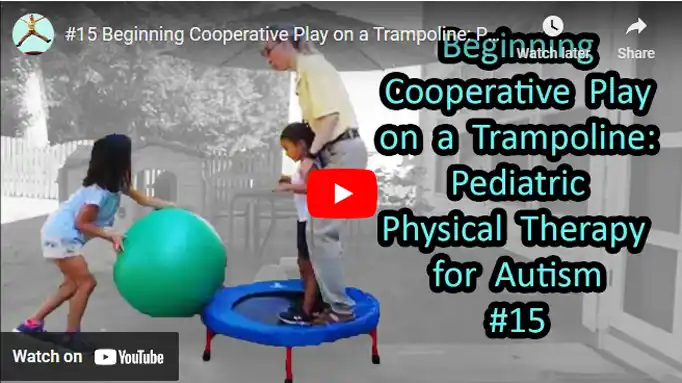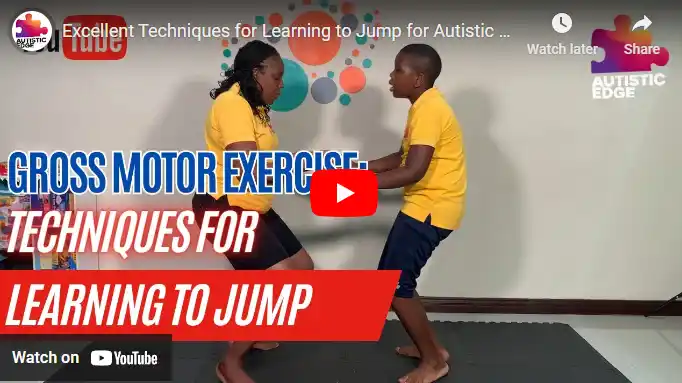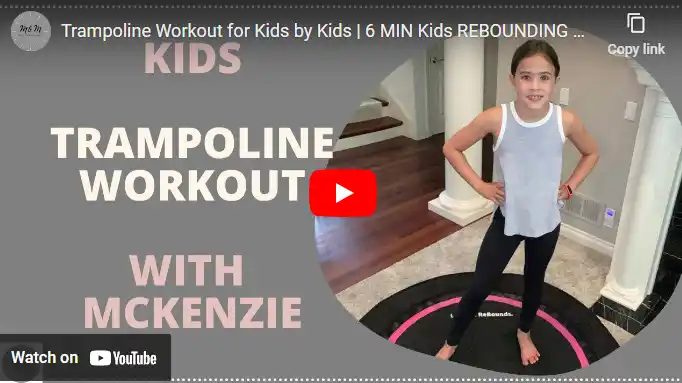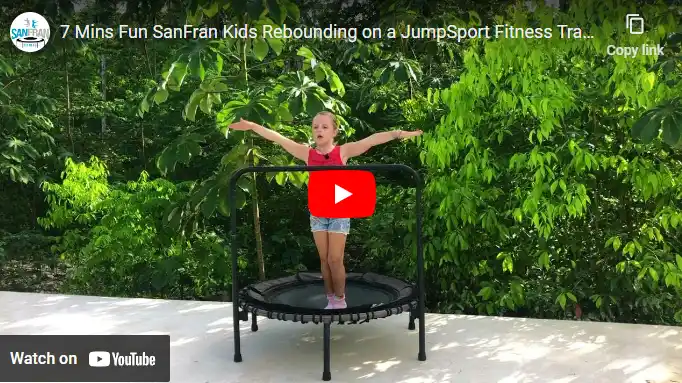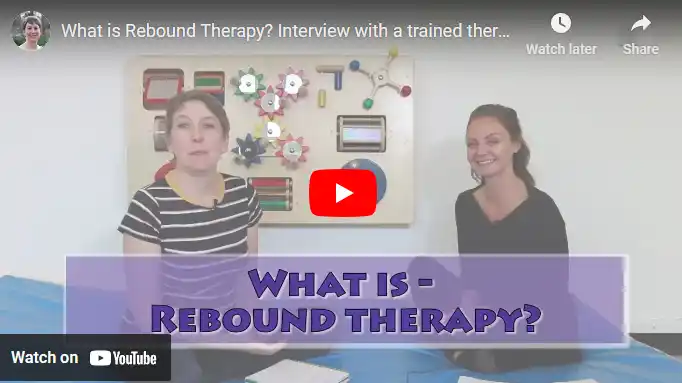Benefits of Trampolines for Autism + What to Look for
Disclaimer: This website exists thanks to you, the readers. When you buy through links on my site, I may earn an affiliate commission.
⚠️ This is a blog post and it cannot provide tailored medical advice for your specific case. Before deciding to buy a trampoline for autism for your child with ASD, please consult your doctor.
Kids with Autism Spectrum Disorder (ASD) face some unique challenges—like communication difficulties, anxiety, sensory overload, and struggles with managing emotions or actions.
But the good news is bouncing on a trampoline can be really helpful, both physically and mentally. C. Lourenço and D. Esteves report in their research paper Inclusion Strategies: A Trampoline Program For Children With Autism Spectrum Disorder:
“A minimum 20-week trampoline training may be a viable therapeutic option for training children with ASD to improve their motor proficiency.”
Dr. Swetha Gandrajupalli, PhD confirms that bouncing on a trampoline regularly can boost focus and coordination. She adds that it also assists in developing new motor skills, strengthening muscles, easing anxiety, and encouraging social interaction.
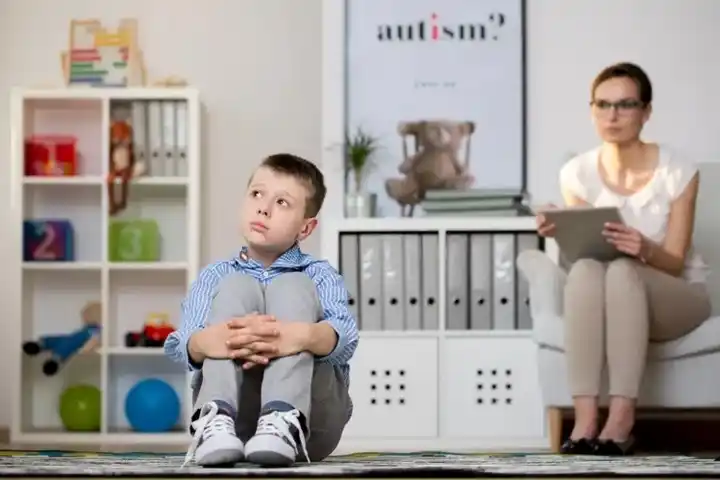
It’s true that autism affects everyone differently, and there’s no one solution, but there are some proven benefits of trampolining for autism. Let’s take a look.
Autism and jumping: How do trampolines help?
Trampolining is a great exercise option that can be especially friendly for people with autism. Research shows that children with Autism Spectrum Disorder (ASD) often face challenges with communication and might find group activities overwhelming. This can lead them to withdraw or isolate themselves.
That’s where trampolining can make a difference—it's an individual activity that takes place in a group setting! This means kids can play on their own while still being part of a social environment. And that’s just one of the benefits of trampolining for people with autism. Let's dive into some of the other positive aspects:
Sensory integration
People with autism often experience sensory imbalances. They usually manage this by doing repetitive movements because, for them, it eases the feelings of anxiety or stress.
Jumping on a mini trampoline is a great option for children on the ASD spectrum because it offers a repetitive, soothing movement that also keeps them active and having fun. This can be especially helpful for those who might otherwise engage in more destructive forms of self-stimulation when feeling nervous.
Improved heart health and endurance
Spending some time on the mini trampoline is proven to boost our cardiovascular system and help improve our heart’s health. There are already studies that prove (jumping on a mini trampoline (also known as rebounding) is a full-body workout that delivers results almost twice as fast as other exercises, while still being gentle on their joints. It boosts blood flow and improves heart health.
All this leads to increased oxygen circulation that can help reduce the risk of heart-related issues and support a healthier, more active lifestyle.
Muscle strength and coordination
The American Physical Therapy Association emphasizes the importance of giving autistic children more opportunities for movement. This is because they often face challenges with developing motor skills and maintaining balance.
Rebounding is a great way to help with these challenges. The uneven surface helps improve coordination, and the jumping action strengthens muscles. Plus, it comes with the added bonus of burning calories, which supports weight management.
Concentration and cognitive functions
Physical activity can have a big impact on the brain. For children with ASD, the right exercise can lead to positive changes in their behavior and daily habits.
Here’s how trampolining can help. When kids with ASD jump on a trampoline, they need to focus to stay balanced. This helps them stay in the moment and improves their ability to control their body. It also makes them feel safer and more aware of their movements.
Improved learning
Trampolining helps kids focus better, which is great for learning. The rhythmic bouncing calms their minds, making it easier to concentrate on tasks. Plus, it’s a fun way to burn off energy while staying engaged.
When you mix in creative games, it not only boosts their imagination but also keeps them excited and motivated to learn. It’s a perfect blend of physical activity and mental stimulation that kids with ASD can really benefit from.
Emotional regulation and stress reduction
The list of benefits of trampolining for autistic children and grown-ups goes on. We already went through the physical and cognitive improvements, but rebounding can also help people with ASD develop new social skills and learn how to reach emotional balance.
Very often people with ASD struggle with emotional dysregulation that might sometimes even go to extremes. Everyday situations that might seem small to others can cause them significant stress. To cope, they often turn to self-soothing behaviors that involve repetitive actions. The simple action of jumping on a trampoline is what can do much of the work in these situations. It can help them reach emotional regulation in a fun way.
Improved mood
As the Autism Education Consultant & Trainer Nelle Frances explains:
“Jumping on a trampoline offers proprioceptive & vestibular sensory input that is incredibly beneficial for autistic children, promoting both physical sensory integration AND emotional regulation. So to promote a better mood... JUMP!”.
Stress and anxiety management
“Jump for joy” may be something people learned long before science proved it. And it is true!
One great thing about trampolines is that jumping helps release endorphins — the "feel-good" chemicals in the brain. For autistic kids who often find managing stress difficult, trampolining can serve as a “safe space”. It can help them release their feelings in a fun and healthy way.
Social interaction and communication skills
It’s common for people with ASD to struggle with socializing and with forming verbal communication skills. Social interactions might be overwhelming for them and this can lead to isolation or anxiety.
Rebounding provides parallel play, where autistic children can easily join. It’s great for them because it helps them avoid interactions that might otherwise cause stress. At the same time, it’s an opportunity to be in a social environment. You can use different creative and simple games while kids are trampolining to help them develop focus and socialize.
The best trampolines for autistic children
Product | My Rating | Verdict | Price |
|---|---|---|---|
This can work as a sensory trampoline for autism because it is sturdy, well-padded, and offers excellent stability. The no-spring design makes it very safe. | |||
This can be a great mini trampoline for autism. It has a strong frame, with a safety mat a foam-covered handlebar. | |||
This outdoor trampoline for autism has all the safety features you can dream of. The net is far from the poles and kids can’t jump over the net. Very nice if you have the space. |
How to choose the right trampoline for a child with autism?
Safety first
Here is a short safety checklist to keep in mind:
- Enclosure Netting. Make sure the trampoline has a safety enclosure net to prevent falls.
- Padding. Check that the springs and frame are well-padded to avoid injuries.
- Weight Limit. Verify the weight capacity to ensure it can support your child safely. There are different types of trampolines for children and grown-ups with different limitations, so the weight limit is a key feature to look for before buying a trampoline.
Sensory needs
When choosing a trampoline for a child with autism, it's important to consider their sensory needs. Autistic children often react to sensory stimuli in two ways: either they are highly sensitive (hyperresponsive) or less sensitive (hyporesponsive). To make trampolining enjoyable and anxiety-free, here are a couple of key things to keep in mind:
- Bounce quality. Some kids may prefer a firmer bounce, while others may feel more comfortable with a softer one. It’s a good idea to try out different trampolines. The type of mat and whether it uses springs or bungees can affect the bounce feel. Typically, bungee trampolines offer a softer bounce with more give and spring trampolines offer a firmer bounce. But there are many exceptions.
- Visual and auditory stimuli. Many autistic children are sensitive to bright colors, loud noises, or patterns. Trampolines with simple designs and minimal noise can help prevent sensory overload. Always aim for a calming and predictable setup.
Size considerations
- Indoor vs. outdoor. Decide if you want an indoor trampoline for autism (generally smaller, around 3-7 feet) or an outdoor one (larger, 8-14 feet or more). Always make sure to have enough empty space, far from other objects to ensure safety. Move away the furniture if you’ve chosen an indoor mini trampoline and make sure to place it far from trees, pools, and other obstacles if you got an outdoor trampoline.
- Space available. Measure the area where you plan to place the trampoline to ensure it fits comfortably. You can also check if it is foldable or not. This can be crucial if you don’t have much space available. Don’t let too much stuff and toys pile around it because those can be a hazard, especially with mini trampolines. If your kid accidentally jumps off it, they may be injured.
- Age and growth. Choose a size that is right for your child’s current age but also allows for growth.
Type of Trampoline
- Mini trampolines. Suitable for indoor use and younger children, these are great for quick, supervised play sessions.
- Standard trampolines. These are larger and typically used outdoors. They can be better if you have several kids at different ages and you want all of them to be able to use the trampoline.
Additional Features
- Handlebars. They are great for extra stability, especially for younger children or those who need more physical support.
- Adjustable tension. Some trampolines allow you to adjust the tension of the mat to customize the bounce.
- Quiet operation. If you need the trampoline to be quiet, you might look for trampolines with quieter springs or bungees. This can be important for children sensitive to sound.
Jump to my top 3 trampolines for autism.
Tips for daily trampoline routines at home for kids with autism
- Start with short, supervised sessions. Shorter sessions help keep your child engaged and prevent overstimulation or meltdowns. You can gradually increase the time as your child becomes more comfortable.
- Establish clear, simple jumping rules. Set basic rules, such as landing on two feet and avoiding the netting, to keep things safe. Keeping the rules simple helps avoid overwhelming your child with too many instructions.
- Use consistent daily trampoline routines. Scheduling trampoline sessions at the same time every day creates a comforting routine. Including sensory toys can make the experience more enjoyable and soothing.
- Play soft, calming background music. Soft, gentle music at a low volume can provide sensory stimulation without being overwhelming. It helps release excess energy while keeping your child calm.
- Use safety nets and padding. Always supervise your child and ensure the trampoline has safety nets and padding. Make sure the trampoline fits your child's specific needs for safety. Here are some more tips to keep in mind when buying a trampoline.
- Celebrate progress. Acknowledge and celebrate your child's progress after each session. Small achievements are significant and can boost confidence and motivation.
- Encourage rhythmic, repetitive bouncing: Rhythmic bouncing is soothing and can ease anxiety. It helps your child relax, making it easier for them to focus and learn new skills. Play soft, calming background music.
Autism-friendly trampoline exercise
When planning exercises for children with autism, keep things simple and adjust based on how they’re feeling that day. It’s important to make sure they’re enjoying themselves while staying active. Here is an example video that shows how to add trampoline exercise to your child’s day:
Create a sensory-friendly environment by keeping music low and avoiding bright lights. For example, you can add trampoline time to their routine in short, fun sessions that fit their energy level.
For more ideas that suit your child’s age and motor skills, you can find exercises tailored to their needs here:
FAQ
What are the best trampoline safety practices for children with autism?
When thinking about safety, start by choosing a trampoline with safety nets, padding, and a handle if needed. Pick the right size based on your child’s age. Keep exercises easy and match them to your child’s fitness level. Always make sure to do a warm-up before starting any activity to avoid injuries.
How often should trampoline activities be integrated into therapy for effective results?
Jumping on a trampoline can easily become part of your child’s daily routine if they enjoy it and feel comfortable. It’s a good idea to start with short, simple sessions and gradually increase the duration as they get more used to it. The great thing about rebound therapy is that it shows benefits on many levels—it helps improve motor skills, balance, coordination, focus, and even social skills. Plus, it’s a fun way for your child to stay active while gaining these skills!
Can trampoline exercises replace other forms of physical therapy?
Trampoline exercises are now part of what's called rebound therapy, which is used for people with various conditions, including autism. One big benefit of rebound therapy is that bouncing on the trampoline helps autistic children get their daily physical activity while improving motor skills, posture, and muscle strength. The uneven surface of the trampoline also helps them develop a sense of balance.
Another advantage is that this activity stimulates the production of dopamine, a chemical that improves brain function. For more details about how rebound therapy works, it's a good idea to consult with a trained therapist who specializes in this area.
Here is more information from a licensed therapist:
What are the signs that trampoline activities are benefiting an individual with autism?
Trampoline activities can have immediate effects on sensory regulation, especially for children with autism. Bouncing provides both proprioceptive and vestibular input, which helps calm the brain. This is especially important for children with ASD, who often struggle with stress and anxiety. The rhythmic bouncing can reduce these feelings while helping release excess energy.
As children become more comfortable on the trampoline, their confidence grows, encouraging them to try new exercises. Over time, you'll likely see improvements in confidence, focus, and overall happiness. Physically, trampolining strengthens muscles, improves posture and coordination, and helps develop new motor skills. These benefits make trampoline exercises a fun and effective way to support both sensory and physical development in children with ASD.
Conclusion
Trampoline jumping is a great mix of fun and exercise, and it’s especially helpful for kids with autism. It supports their social, emotional, and physical growth. When you see your child enjoying themselves and improving their skills, you’ll know the trampoline was a good choice.
You can buy a trampoline for home, either for indoor or outdoor use, so your child can enjoy the benefits whenever they like. Just remember to choose a safe trampoline with things like nets and padding, and always supervise your child while they’re jumping to keep them safe.
References and further reading
- Autism Speaks
- US Autism Association
- Lourenço, Carla & Esteves, Dulce. (2021). Inclusion Strategies: A Trampoline Program For Children With Autism Spectrum Disorder
- Shaza Khatab, Mohamad Hassan Fadi Hijab, Achraf Othman, Dena Al-Thani, 2024, Collaborative play for autistic children: A systematic literature review
- How Does Exercise Affect Your Brain (Grades 6-8)
- Wen, X., Zhang, Y., Gao, Z., Zhao, W., Jie, J., & Bao, L. (2018). Effect of Mini-Trampoline Physical Activity on Executive Functions in Preschool Children.

